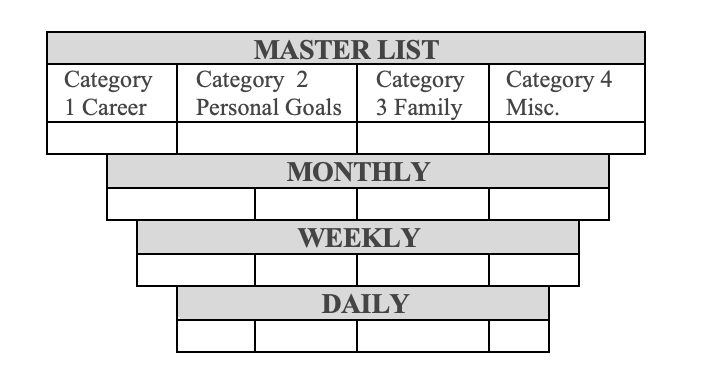The last blog covered the importance of mapping out our high-level plan, including our purpose, vision, and values. Now we can jump into creating a daily practice of planning and prioritizing.
Author and Organizational Consultant David Allen, a master of prioritization and planning, offers his Getting Things Done (GTD) system for organization. His 5-step process – capture, clarify, organize, reflect, and engage with your stuff – helps us get more precise with our work.
1. Capture. We need different lists for different purposes. First, make a master list, where you capture everything you need to do in one spot that is out of your mind. This thought-download exercise will provide a sense of relief. Allen asserts, “Your mind is for having ideas, not for holding them.” If we put things in an external drive, we can free up mental space and be fully engaged with our current tasks and be more present with the people in our lives. You can create categories of things that are important to you for more significant organization. You can also have a “someday maybe” list of items that could be interesting to explore eventually. For example, consider taking the marketing course, look into taking the family to this event. You can then further divide your work into monthly, weekly, and daily lists. Don’t worry about the number of items, just get as much down on the paper as possible.

2. Clarify. Get clear on all the things you have to do. Break down your big items into parts. Instead of having the task of “write a blog,” you can split it into its components parts such as: 1. Create an outline 2. Research 3. Write the first draft. 4. Proofread 5. Post. It seems like a small simple action, but it makes a big difference if it means that you are more likely to start when you know all you have to do is jot down an outline instead of doing all those prerequisite steps for publication.
3. Organize. You can arrange your actionable items by category, priority, and due date. As productivity consultant Brian Tracy explains, your monthly list pulls from your master list. Your weekly list pulls from your monthly list. And so on. This way, you know your daily priorities align with your bigger goals.
When completing your different lists, remember the Pareto Principle, that is 20% of your efforts tend to produce 80% of your results. Look for those tasks that bring you great gains.
4. Reflect. Reflect on your to-do list. Allen recommends doing this weekly and performing general clean up. It is a time to see how your week went, what needs to be adjusted, and what needs to happen for the week ahead. This airplane view will allow you to see if your priorities are aligning with your purpose, visions, and goals and if they are not, you can choose to delegate, cancel or reschedule some of your non-essential tasks.
5. Engage. Take action – choose your next task from your list and get it done. If you find that you are stalling, break up the task, maybe the next step is to have a couple of conversations with others to get ideas on how to proceed. Once you take the next step, you will receive information that you can act upon.
While you are planning, it is essential to be flexible. What you want today can be different from what you want in the future so you need to occasionally check in with yourself to make sure your values and goals are crystal clear and current. Reshuffling priorities and making changes are all part of the process.
The very act of thinking and planning unlocks your mental powers and triggers your creativity. Choose a process that will allow you to take action on the work that matters most to you.
Quote of the day: “Cleaning and organizing is a practice, not a project” -Meagan Francis
Q: Which method do you use for organizing your information? Comment and share with us, we would love to hear from you!
[The next blog in this series 4/5 will focus on systems of prioritization]
As a Leadership Coach, I partner with others to get clarity on their priorities, contact me to learn more.


